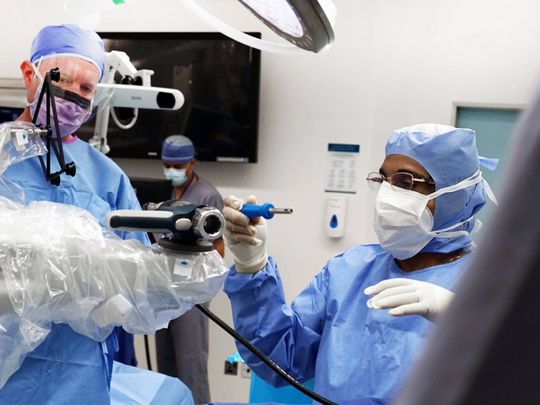
Abu Dhabi: A new technology is now available in the UAE for robotic-assisted knee replacement surgery, Mubadala Health announced on Tuesday.
Healthpoint, a Mubadala Health partner, has conducted the surgery using the ‘Mako’ robotic arm by Stryker, which is a new technology that has been brought into the UAE by Healthpoint.
The newly offered technology provides “greater accuracy, better outcomes, faster recovery, and less pain for patients” in comparison to hip and knee joint replacements done with traditional techniques.
Omar Al Naqbi, Executive Director, Healthpoint said: “We are dedicated to delivering the best possible clinical outcomes for our patients, and the introduction of robotic arthroplasty surgery at Healthpoint through this exclusive technology affirms our position as the number one provider of orthopaedic surgeries in the region.”
The technology is being brought exclusively to Healthpoint by “one of the most prominent orthopaedic robotic surgeons within the industry”, UK-based Dr Jonathan Conroy. He has conducted over 750 surgeries with the assistance of a robot.
Dr Conroy said: “This type of robotic surgery is offered widely abroad and is now available to patients here in the UAE. In tandem with the surgeon, the system is able to perform extremely accurate incisions on the bone, which has been proven to result in a quicker recovery and more positive long-term results. We have seen patients receiving the robotic surgery who are able to go home the very same day. From my experience, I’ve witnessed patients coming off their crutches within two-to-four weeks. We also noticed less swelling and pain.”
How it works
The orthopaedic robotic arm-assisted surgery helps surgeons plan for the operation. Following a CT scan, a 3D model is created that can be viewed from all angles using digital technology and a computer screen, which is unique to this technology. This allows the surgeon to envisage how the hip or knee joint will move functionally. The joint replacement can be assessed before any surgery is carried out so that the medical team can model what surgery to do – almost serving as a mock practice. The benefit is ultimately for the patient, whose new joint will work better, with greater accuracy in the size and placement of the implant, as well as the improved angles of cutting into bone that ultimately reduces pain and improves function.











